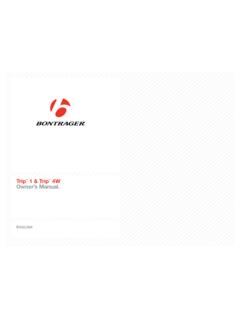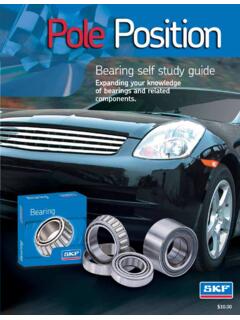Transcription of P Chassis - Offroadtoybox
1 P Chassis for MotorHomes General Information for alignment DRAFT. 1 Version Sep 14, 2005. Introduction The intent of this document is to provide both reference information and guidance for getting the Chevrolet P Chassis to perform as it was designed to perform. A majority of the information is taken from the 1995 and 1997 Chevrolet Motor Home Chassis Service Guide for the P Chassis . However, the information has been presented in what is felt to be a logical sequence to accomplish that most elusive item for this Chassis good handling. Age is the common enemy of the Chassis . It has been around a long time and many of the older motorhomes on this Chassis are showing signs of age. The idea here is to simply get appropriate repairs done to bring the Chassis back to reasonable condition and then figure out the correct specifications for alignment .
2 Along the way, you have probably encountered your share of not-so-competent mechanics and/or alignment shops. Matter of fact, many alignment shops simply don't know how to deal with this motorhome version of the P Chassis and wind up treating it like a truck. We will show you that simply telling the alignment shop that it's a P30 Chassis will almost guarantee you an incorrect alignment . Your Class A motorhome is NOT built on a P30. Chassis . The correct general term is a Motorhome P Chassis . The P Chassis was also used for what is referred to as a Commercial (Forward Control) truck. The same Chassis series has been used for G10, G20, G30, P20, P30, and Motorhomes under a '32 - 52' designation. What's more, the alignment specs are different for the motorhome Chassis because they were made slightly different.
3 If you decide to do some of the repair work yourself, such as replacing bushings, remember that you can generally 'rent' specialty front end tools from your local parts store at a cost of $ when you buy the parts from them. A deposit is all that is generally required. You can probably get some good instructions on safely using the tools too. Chevrolet had 7 model numbers for the Motor Home P Chassis , only the ones with '-52' were destined for Class A motorhomes. Class C motorhomes were also built on some of the Commercial truck Chassis . P30832 125 wheelbase P31132 - 52 137 wheelbase P31432 - 52 159 wheelbase P31832 - 52 178 wheelbase P31932 - 52 190 wheelbase (Start-up production in 1991) ( wheels). P32032 - 52 208 wheelbase (Start-up production in 1988) ( wheels). P32132 - 52 228 wheelbase 2 Version Sep 14, 2005.
4 The Motorhome Chassis also has different frame rails. Be careful to NOT use adjustment/maintenance information from a Forward Control Chassis manual for your Class A. motorhome. Some things are common, some things are not. It is unfortunate that even GM's documentation varies in what it names these Chassis . The P30 term is simply too generic to help when specifics are needed. If the 5th thru 7th positions in your VIN number are P37 , then you have the motorhome version of the Chassis . Actually, it is the '7' that tells us we have the motorhome version of the Chassis . (See Appendix C for the VIN breakdown.). But, not to get too far ahead of the process we will describe on the following pages. Stay with it and I think you will come out happy in the end. 3 Version Sep 14, 2005. Table of Contents The Worn Air Ride Frame Appendix A Front Load Height Appendix B Rear Load Height Appendix C Appendix D An alignment Appendix E Tire Inflation (as of 1995).
5 27. Appendix F How do I determine my rear axle ratio?..30. Appendix G Chart for properly matching tires to Weights 4 Version Sep 14, 2005. The Process The first step to maintaining proper vehicle handling is through the regular inspection and replacement of suspension bushings, ball joints, tie rod ends and just about everything else that makes up the front and rear end suspensions of the motorhome. The second step is to perform a suspension alignment . Sounds straightforward enough, but the P Chassis has been given a reputation for not handling very well, even after an alignment has been done. The catch seems to be that many of the motorhomes experiencing drivability problems have old, worn, saggy parts. Sound familiar? Not only that, but there doesn't seem to be a lot of expertise out there in alignment shops for this Chassis .
6 In other words, you have to take the ball in your own hands and verify everything is checked and in good shape BEFORE. an alignment is performed, even to the point where YOU supply the alignment specs to the alignment shop. Let's go through the process in a step-by-step manner. Worn Parts Make sure that worn parts are replaced, everything is tight, everything is there and a proper lube job has been done. What worn parts? 1. Ball joints 2. Tie rod ends 3. Steering relay rods 4. Damper (that horizontal shock). 5. Steering gear 6. Shock absorbers 7. Loose control arms 8. Loose or missing stabilizer bar attachments 9. Front wheel bearings , including those on the torsion bars front and rear. bags properly inflated problems Some details: Before you attempt to crawl under the front end for inspection, it might be worthwhile to take a trip to the local car wash where you can use a high pressure spray to knock off the gunk.
7 Steam cleaning, solvent and elbow grease are alternatives. Don't forget goggles to protect your eyes and wear junky clothes. Don't point that high-pressure spray directly on the air bags and any 5 Version Sep 14, 2005. hoses or the bottom of the radiator. You can drill right through, just like you can drill through your own hand if you point it incorrectly. Don't forget to clean the rear axle housing too. Proper lube of ball joints means lifting the motorhome by a frame member so the suspension hangs free and then lube the zerks. Don't forget to wipe the zerks clean before you lube. Otherwise, you will be pushing gritty dirt into the joint. If the motorhome is lifted for lubrication by driving up on wheel ramps, the ball joints are under enough tension to inhibit full flow around the entire ball socket. Also, when lifted like this, it is a good time to check ball joint wear.
8 To do this you will need a caliper that will measure the lower ball joint distance between the tip of the ball stud and tip of the grease fitting below the ball joint while the suspension hangs free. Then, change the point you are lifting the front end so that you are supporting the weight of the control arms at each wheel or each lower control arm. Again measure between the same points on each lower ball joint. The difference between the two measurements for each should not exceed 3/32 of an inch. Remember, even new ball joints have play in them. If they didn't, they wouldn't move. If you replace, replace in pairs. 6 Version Sep 14, 2005. Look at all the rubber washers and bushings for cracks, bulges and wear. The upper and lower control arm bushings get pretty bad after 10-20 years. These are cheap to buy and labor is the real price.
9 If you can replace them yourself, do it. Also, using a spray-on rubber lube on suspension points on a regular basis is cheap insurance once you know they are in good shape. The steering linkage is located forward of the front cross member. The P Chassis linkage is illustrated below. Steering effort is transmitted to left- and right-hand adjustable tie rods through a relay rod. The relay rod is connected to an idler arm on the right and to the pitman arm on the left. The fit of the shafts in the linkage support assemblies should be tight with end play not exceeding .003. If it exceeds .003 inches in either assembly, adjust to within 0 to .003 inches. Set large lock nut torque cap to 25 ft. lbs. and then loosen 1/16 turn and tighten lock nut. If there is side play, replace the bushings. Lube the linkage under 'normal' conditions every 7,500 miles or every 3,000 miles if used in 'dusty' conditions.
10 The support assembly in the illustration below is also known as a bellcrank . Many motorhomes sit in storage for a long time between use. That steering damper (it's really a shock absorber) can accumulate rust on its horizontal exposed rod. If it does get heavily rusted and you just jump in after a long storage period and drive off, that rusty rod may rip up the seal as soon as it moves inward. Good idea to check it and possibly clean it off. Turn the steering wheel so as to extend the rod fully while you check it. If it's badly rusted, it's probably a good idea to replace the damper. Same thing applies to the shocks. Think about some preventive measures added to your pre-storage checklist to help prevent this situation. Check the damper attachments to make sure they are tight. Rubber bushings should be replaced if they are worn, cracked or crushed.




